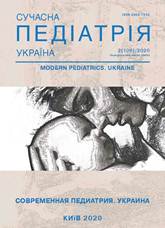Thyroid Dysfunction and Childhood Obesity (literature review and own research)
Keywords:
children, obesity, thyroidopathy, treatmentAbstract
The prevalence of obesity is steadily growing among both adult and child population. In recent years, among the pathologies associated with obesity, more and more attention of researchers has been attracted by thyroid pathologies, which in Ukraine occupy the leading place by frequency among all endocrinopathies. A relevant issue in pediatric endocrinology is to determine the relationship between thyroid dysfunction and obesity. According to modern research data, there is a close relationship between manifestations of metabolic syndrome and functional state of the thyroid gland. The results of the studies showed that the most vulnerable period for the occurrence of thyroid dysfunction in obese patients is the prepubertal period in boys (6-9 years) and early puberty (10–13 years) in girls. This proves need to monitor the state of the thyroid gland in obese patients, especially during pre- and early puberty. It has also been proved that the presence of disorders in the structure of the thyroid gland in children with obesity, even in the absence of other signs of autoimmune thyroiditis, can be considered as a risk factor for the formation of thyroid insufficiency, which requires constant monitoring of the functional state of the thyroid gland in such patients. To optimize the examination and treatment of obese children and adolescents, an observation algorithm is proposed for the first level of medical care.
References
Averyanov AP, Bolotova NV, Zotova SA. (2010). Ozhirenie v detskom vozraste. Lechaschiy vrach. 2: 66–69.
Budreyko OA, Kosovtsova GV, Nikitina LD, Mihaylova EA et al. (2016). Shushlyapina OV.. Diferentsiyovane likuvannya uskladnenogo perebigu ozhirinnya u ditey ta pidlitkiv. Harkiv: Krokus: 27.
Zelinska NB, Larin OS. (2016). Patologiya schitopodibnoyi zalozi u dityachogo naselennya Ukrayini. Klinichna endokrinologiya ta endokrinna hirurgiya. 3: 76–81.
Zelinska NB, Rudenko NG. (2017). Dityacha endokrinologiya v Ukrayini: statistichni pokazniki za pidsumkami 2016 roku ta yih dinamika. Ukrayinskiy zhurnal dityachoyi endokrinologiyi. 2(22): 5–17.
Matyusheva NB, Saprina TV, Vorozhtsova IN. (2011). Gormonalnometabolicheskiy patomorfoz narusheniy uglevodnogo obmena u podrostkov s ozhireniem. Sibirskiy meditsinskiy zhurnal. 4: 141–145.
Mitchenko OI, Romanov VYu, Logvinenko AO, Gvozdik MV, Chulaevska IV. Sertsevo-sudinniy rizik na tli disfunktsiyi schitopodibnoyi zalozi. (2012). Medichna gazeta Zdorov'ya Ukrayini. 3: 27–29.
MOZ Ukrayini. (2006). Protokol nadannya medichnoyi dopomogi dityam za spetsialnistyu «Dityacha endokrinologiya»: nakaz MOZ Ukrayini N254 vid 27.04.2006 r. Kyiv: 88.
Pankiv VI. (2011). Praktichna tireoyidologiya. Donetsk: Vidavets Zaslavskiy OYu: Simpozium. 54: 224.
Skripnik NV, Vatseba TS. (2011). Vzaemozv'yazok mizh insulinorezistentnistyu ta gipotireozom u hvorih na tsukroviy diabet 2 tipu z metabolichnim sindromom. Liki Ukrayini. 10: 31–32.
Turchina SI, Nachetova TA. (2017). Distireoz yak faktor riziku formuvannya vtorinnoyi amenoreeyi u divchat, yaki meshkayut v umovah slabkogo yododefitsitu. Zdorove zhinki. 8 (124): 14–16.
Shushlyapina OV. (2017). Osoblivosti lipidnogo obminu u ditey z ozhirinnyam ta tireopatiyami. Problemi endokrinnoyi patologiyi. 3: 71–77.
Shushlyapina OV, Budreyko OA. (2017). Vpliv Insulinorezistentnosti na funktsionalniy stan schitopodibnoyi zalozi u ditey z ozhirinnyam. Ukrayinskiy zhurnal dityachoyi endokrinologiyi. 2: 18–23.
Biondi B. (2010). Thyroid and obesity: an intriguing relationship. The Journal of Clinical Endocrinology & Metabolism. 95(8): 3614–3617. https://doi.org/10.1210/jc.2010-1245; PMid:20685890
Bougle D, Morello R, Brouard J. (2014). Thyroid function and metabolic risk factors in obese youth. Changes during follow-up: a preventive mechanism? Experimental and Clinical Endocrinology & Diabetes. 122(9): 548–552. https://doi.org/10.1055/s-0034-1377046; PMid:25140994
Brienza C, Grandone A, Di Salvo G et al. (2013). Subclinical hypothyroidism and myocardial function in obese children. Nutr Metab Cardiovasc Dis. 23: 898–902. https://doi.org/10.1016/j.numecd.2012.04.006; PMid:22748710
Cerbone M, Capalbo D, Wasniewska M et al. (2014). Cardiovascular risk factors in children with long-standing untreated idiopathic subclinical hypothyroidism. J Clin Endocrinol Metab. 99(8): 2697–2703. https://doi.org/10.1210/jc.2014-1761; PMid:24840815
Eliakim A, Steinberg N, Pantanowitz M et al. (2013). Effect of a weight management program on postural balance in obese children. European Journal of Pediatrics. 172(12): 1619–1626. https://doi.org/10.1007/s00431-013-2090-8; PMid:23881343
Garnerone L, Iorio L, Zelaschi R. (2010). Thyroid function and obesity. Minerva Medica. 101(5): 363–370.
Iwen K, Schroder E, Brabant G. (2013). Thyroid hormones and the metabolic syndrome. European Thyroid Journal. 2(2): 83–92. https://doi.org/10.1159/000351249; PMid:24783045 PMCid:PMC3821514
Longhi S, Radetti G. (2013). Thyroid function and obesity. J. Clin. Res. Pediatr. Endocrinol. 5(1): 40–44.
Marras V, Casini M, Pilia S et al. (2010). Thyroid function in obese children and adolescents. Horm Res Paediatr. 73(3): 193–197. https://doi.org/10.1159/000284361; PMid:20197672
Monzani A, Prodam F, Rapa A et al. (2012). Endocrine disorders in childhood and adolescence. Natural history of subclinical hypothyroidism in children and adolescents and potential effects of replacement therapy: a review. Eur J Endocrinol. 168(1): 1–11. https://doi.org/10.1530/EJE-12-0656; PMid:22989466
Reinehr T. (2011). Thyroid function in the nutritionally obese child and adolescent. Curr Opin Pediatr. 23(4): 415–420. https://doi.org/10.1097/MOP.0b013e328344c393; PMid:21430532
Downloads
Published
Issue
Section
License
The policy of the Journal “MODERN PEDIATRICS. UKRAINE” is compatible with the vast majority of funders' of open access and self-archiving policies. The journal provides immediate open access route being convinced that everyone – not only scientists - can benefit from research results, and publishes articles exclusively under open access distribution, with a Creative Commons Attribution-Noncommercial 4.0 international license (СС BY-NC).
Authors transfer the copyright to the Journal “MODERN PEDIATRICS. UKRAINE” when the manuscript is accepted for publication. Authors declare that this manuscript has not been published nor is under simultaneous consideration for publication elsewhere. After publication, the articles become freely available on-line to the public.
Readers have the right to use, distribute, and reproduce articles in any medium, provided the articles and the journal are properly cited.
The use of published materials for commercial purposes is strongly prohibited.

